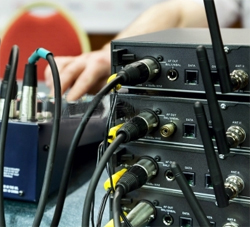There are four wireless microphone mistakes that get a sound tech in trouble. The first mistake is one I’m often asked about.
I’ll be upfront and say that I’ve made two of these mistakes. Two, maybe three. No, two. Forgive and forget, right? [sigh]
1. Allow signal seepage (that sounds… disgusting!)
It goes like this;
1) Channel gain (trim) knob is at zero.
2) Fader is at unity or below.
3) The wireless signal still seeps (bleeds) through into the channel and out the main loudspeakers.
Why does this happen when the gain is turned to zero? The answer is simple and the solution even simpler. The wireless pack has a gain control. If the pack’s gain is too high, then it’s sending a massively strong signal to the mixer. The mixer can’t handle it. So, even with the channel gain at zero, the signal bleeds through.
Correct this by following these steps:
1) Turn the wireless pack’s gain almost all the way down.
2) Turn the channel’s gain to the 9 o’clock position.
3) Set the channel fader at unity.
4) Have the person who normally uses that wireless microphone use it as they normally would; talk or sing, ummm, normally.
5) Listen. If the house volume is too loud, have them turn down the pack’s gain. More likely, it will be too soft and they will need to turn it up. Have them make changes in minor increments. Once the house volume is right, by turning down the channel gain, no sound would come through the channel.
A final note on this, check all input devices for proper signal levels coming in. Nothing like fading out a music track, from a computer, only to hear it still playing in the house speakers.
2. Let them die on stage (alas, poor nine-volt! I knew him, Horatio.)
When should the batteries in wireless microphones be replaced? The answer is not “when the mic dies.” It’s not that any of us want the embarrassment of having the pastor’s microphone die mid-sermon. The problem is battery management is often the last thing on the Sunday-morning to-do list.
Make battery management a priority. Keep the rechargeable batteries recharged. In case of multiple weekend services, check the battery meter on the wireless devices between services. If it’s low, swamp in fresh batteries.
Not using rechargeables? Not a problem. Know how long the batteries should last under normal usage, check their charge, and replace them before they die. We use non-rechargeables in our wireless guitar/bass packs. They last for the full Wednesday night practice, Saturday practice, Saturday service, and through both Sunday services. We put new batteries in immediately before the Saturday service. This way, when (or if) they do die during use, it’s during the next Wednesday or Saturday practice.





















